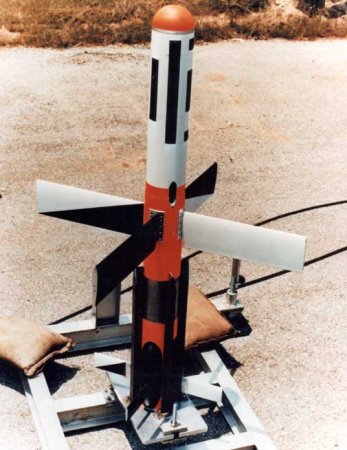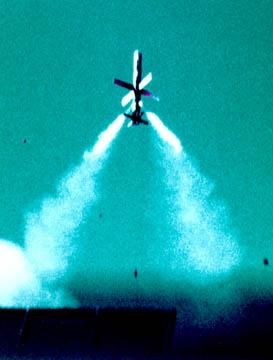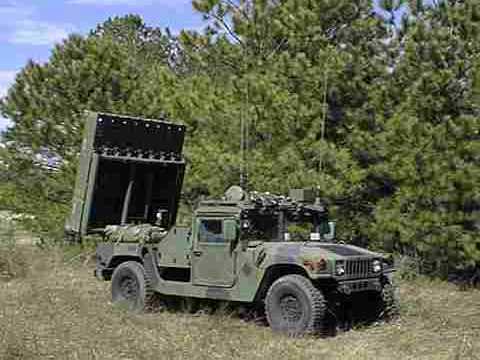Raytheon MGM-157 EFOGM
The EFOGM (Enhanced Fiber Optic Guided Missile) was a U.S. Army ATD (Advanced Technology Demonstration) program to evaluate a fiber-optically guided precision anti-tank and anti-helicopter battlefield missile.
Development of EFOGM can be traced back to 1984, when the U.S. Army began the two-year FOG-M (Fiber Optic Guided Missile) demonstration program. The FOG-M used the motor of a BGM-71 TOW missile, had a TV camera in the nose and a fiber-optic cable instead of the conventional guidance wire. The cable acted as a data link which transmitted the camera's image to the operator, who could then send guidance commands to the missile. In November 1987, a request for proposals for a tactical FOG-M was issued to the industry, and in December 1988, a FOG-M development contract was awarded to a Boeing/Hughes team. However, the FOG-M program was cancelled in 1990.
In 1992, the FOG-M was revived as a technology demonstration program. In early 1994, the Army released a request for proposals for a new EFOGM (Enhanced FOG-M), and allocated the designation YMGM-157A to the missile. In May 1995, Raytheon was awarded a contract to develop the EFOGM. In August 1995, a so called Early Soldier Evaluation (ESE) was conducted by the U.S Army, which evaluated general system design and handling characteristics. Further simulations and evaluations followed through 1996, and all these preliminary studies have presumably led to some design changes in the EFOGM missile, because when the first missiles were flight tested in 1998, the designation had changed to YMGM-157B. The designation DMTM-157B applied to a completely inert version for ground handling training.
 |
| Photo: U.S. Army |
| YMGM-157B |
The YMGM-157B was launched vertically from an 8-missile launcher on an XM44 Fire Unit, based on the HMMWV (High Mobility Multipurpose Wheeled Vehicle). The missile was powered by a dual-thrust (boost/sustain) solid-fueled rocket motor, and could achieve a range of up to 15 km (9.3 miles). The EFOGM was a non-line-of-sight weapon, and could be launched at a target while the Fire Unit was protected behind a hill. The path to the general target area was programmed before launch by selecting several waypoints, and the missile would follow the preselected flight path using its Inertial/GPS guidance unit. The YMGM-157B had cruciform wings and tail fins for stabilization and control during its non-ballistic flight. For terminal guidance, the operator selected the exact point of impact by using the images of the CCD-based TV camera or the IIR (Imaging Infrared) sensor. These images were transmitted via the fiber-optic cable, which was spooled out from the missile. The operator could either manually control the EFOGM until impact, or lock the missile's tracker on a selected impact point. The EFOGM's shaped charge warhead was detonated by an impact fuze. Because the YMGM-157B flew at altitudes of about 300 m (1000 ft) above ground, armoured targets were attacked from the top, which is the most vulnerable area of tanks. The EFOGM could also be used against low-flying helicopters.
 |
 | |
| Photo: Raytheon | Photo: U.S. Army | |
| YMGM-157B | XM44 Fire Unit |
Several successful guided test flights of EFOGM were made through 1998 and 1999, and in 2000, the U.S. Army began the two-year EUE (Extended User Evaluation) phase of the program. The EUE was intended to demonstrate the operational deployment of an EFOGM Company. By June 2002 the EFOGM ATD (Advanced Technology Demonstration) was essentially complete, but the Army cancelled further funding of EFOGM, and so the program was terminated. A total of about 300 YMGM-157B missiles had been built for the EFOGM program.
Specifications
Note: Data given by several sources show slight variations. Figures given below may therefore be inaccurate!
Data for YMGM-157B:
| Length | 1.94 m (6 ft 4.4 in) |
| Wingspan | 114 cm (44.9 in) |
| Diameter | 16.6 cm (6.55 in) |
| Weight | 53.3 kg (118 lb) |
| Speed | 100 m/s (330 fps) |
| Range | 15 km (9.3 miles) |
| Propulsion | Dual-thrust solid-fueled rocket motor |
| Warhead | Shaped charge |
Main Sources
[1] Hajime Ozu: "Missile 2000 - Reference Guide to World Missile Systems", Shinkigensha, 2000
[2] EFOGM System Website (originally at http://efogm.redstone.army.mil/, now dead link (31 March 2004))
[3] Army Technology Website:
"EFOGM - Anti-Armour Missile",
Net Resources International Ltd., 2001
Back to Current Designations Of U.S. Unmanned Military Aerospace Vehicles
Back to Directory of U.S. Military Rockets and Missiles
Last Updated: 16 June 2002